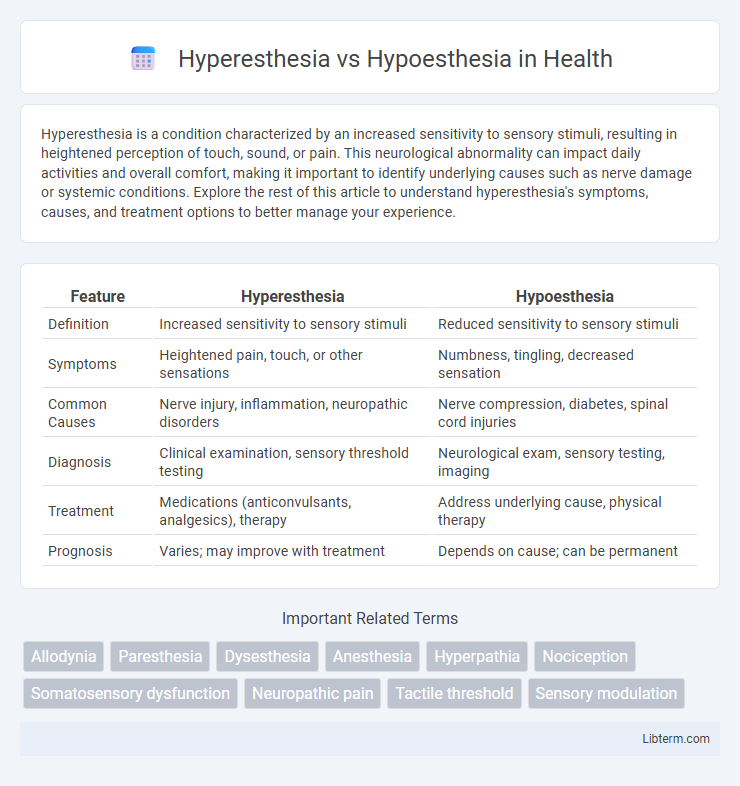Hyperesthesia is a condition characterized by an increased sensitivity to sensory stimuli, resulting in heightened perception of touch, sound, or pain. This neurological abnormality can impact daily activities and overall comfort, making it important to identify underlying causes such as nerve damage or systemic conditions. Explore the rest of this article to understand hyperesthesia's symptoms, causes, and treatment options to better manage your experience.
Table of Comparison
| Feature | Hyperesthesia | Hypoesthesia |
|---|---|---|
| Definition | Increased sensitivity to sensory stimuli | Reduced sensitivity to sensory stimuli |
| Symptoms | Heightened pain, touch, or other sensations | Numbness, tingling, decreased sensation |
| Common Causes | Nerve injury, inflammation, neuropathic disorders | Nerve compression, diabetes, spinal cord injuries |
| Diagnosis | Clinical examination, sensory threshold testing | Neurological exam, sensory testing, imaging |
| Treatment | Medications (anticonvulsants, analgesics), therapy | Address underlying cause, physical therapy |
| Prognosis | Varies; may improve with treatment | Depends on cause; can be permanent |
Understanding Hyperesthesia and Hypoesthesia
Hyperesthesia involves an increased sensitivity to stimuli, often causing heightened pain or discomfort from normally non-painful inputs, while hypoesthesia is characterized by a reduced or diminished sensation in response to stimuli. Both conditions result from disruptions or damage to the nervous system, affecting sensory nerve function and signal transmission. Understanding hyperesthesia and hypoesthesia is critical for diagnosing neuropathic disorders and tailoring effective treatment strategies based on the specific sensory deficits or excesses presented.
Defining Hyperesthesia: Symptoms and Causes
Hyperesthesia is characterized by an increased sensitivity to sensory stimuli such as touch, sound, or light, often causing discomfort or pain. Symptoms include heightened tactile sensitivity, burning sensations, and an exaggerated response to normally non-painful stimuli. Common causes involve nerve damage, neurological disorders like multiple sclerosis, and peripheral neuropathy, which disrupt normal sensory processing.
Overview of Hypoesthesia: Signs and Etiology
Hypoesthesia, characterized by reduced or diminished sensation, commonly presents as numbness or decreased sensitivity to touch, temperature, or pain. Signs include localized or widespread sensory deficits, often accompanied by tingling or a "pins and needles" sensation. Etiology frequently involves nerve compression, peripheral neuropathy, spinal cord injury, or systemic conditions such as diabetes mellitus and multiple sclerosis.
Key Differences Between Hyperesthesia and Hypoesthesia
Hyperesthesia is characterized by an increased sensitivity to sensory stimuli, often resulting in heightened pain or tactile response, whereas hypoesthesia involves a reduced or lost sensation in specific areas of the body. The key differences lie in the sensory perception levels: hyperesthesia causes exaggerated sensory input, while hypoesthesia manifests as numbness or diminished sensory awareness. Clinically, hyperesthesia is associated with conditions like neuropathic pain or postherpetic neuralgia, whereas hypoesthesia frequently occurs in peripheral neuropathy or nerve compression injuries.
Common Underlying Conditions
Hyperesthesia and hypoesthesia are sensory disorders characterized by increased and decreased sensitivity to stimuli, respectively, often linked to neurological conditions such as diabetic neuropathy, multiple sclerosis, and peripheral nerve injuries. Hyperesthesia commonly arises in cases of nerve damage or irritation, leading to heightened pain perception, while hypoesthesia typically results from nerve compression or damage causing reduced sensation. Both conditions may also occur in metabolic disorders, infections, or as side effects of medications affecting the nervous system.
Diagnostic Criteria and Assessment Methods
Hyperesthesia involves heightened sensitivity to sensory stimuli, diagnosed through quantitative sensory testing (QST) measuring pain thresholds and response to tactile stimuli, while hypoesthesia refers to diminished sensation detected via clinical neurological examination and monofilament testing. Electrophysiological studies, such as nerve conduction studies and somatosensory evoked potentials, assist in differentiating nerve function abnormalities associated with both conditions. Accurate diagnosis relies on a combination of patient-reported symptoms, standardized sensory assessments, and objective neurophysiological evaluations to guide targeted management.
Treatment Options for Hyperesthesia
Treatment options for hyperesthesia focus on managing nerve sensitivity through medications such as anticonvulsants, antidepressants, and topical analgesics that reduce abnormal nerve activity. Physical therapy and desensitization techniques help restore normal sensation and improve functional outcomes. In severe cases, nerve blocks or neuromodulation therapies like transcutaneous electrical nerve stimulation (TENS) may be employed to alleviate hyperesthetic symptoms.
Managing Hypoesthesia: Therapeutic Approaches
Managing hypoesthesia involves targeted therapeutic approaches such as physical therapy to stimulate nerve function and enhance sensory recovery. Neuromodulation techniques, including transcutaneous electrical nerve stimulation (TENS), can alleviate numbness by promoting nerve regeneration. Pharmacological treatments like corticosteroids or neuropathic pain medications support reducing underlying inflammation and improving sensory perception.
Preventing Sensory Disorders
Maintaining optimal nerve health through balanced nutrition rich in vitamins B12 and E supports prevention of sensory disorders such as hyperesthesia and hypoesthesia. Regular protective measures against nerve damage, including avoiding repetitive trauma and managing chronic conditions like diabetes, reduce the risk of developing abnormal sensory responses. Incorporating routine neurological assessments facilitates early detection and intervention, minimizing the progression of sensory dysfunctions.
When to Seek Medical Attention for Sensory Changes
Seek medical attention for hyperesthesia or hypoesthesia if sensory changes persist beyond a few days, worsen, or are accompanied by weakness, numbness, or pain, indicating possible nerve damage or underlying neurological conditions. Immediate medical evaluation is critical if sensory alterations follow trauma, are sudden in onset, or involve the face, as these may signal stroke or other serious disorders. Early diagnosis through neurological examination and imaging prevents complications and guides effective treatment for sensory dysfunction.
Hyperesthesia Infographic

 libterm.com
libterm.com